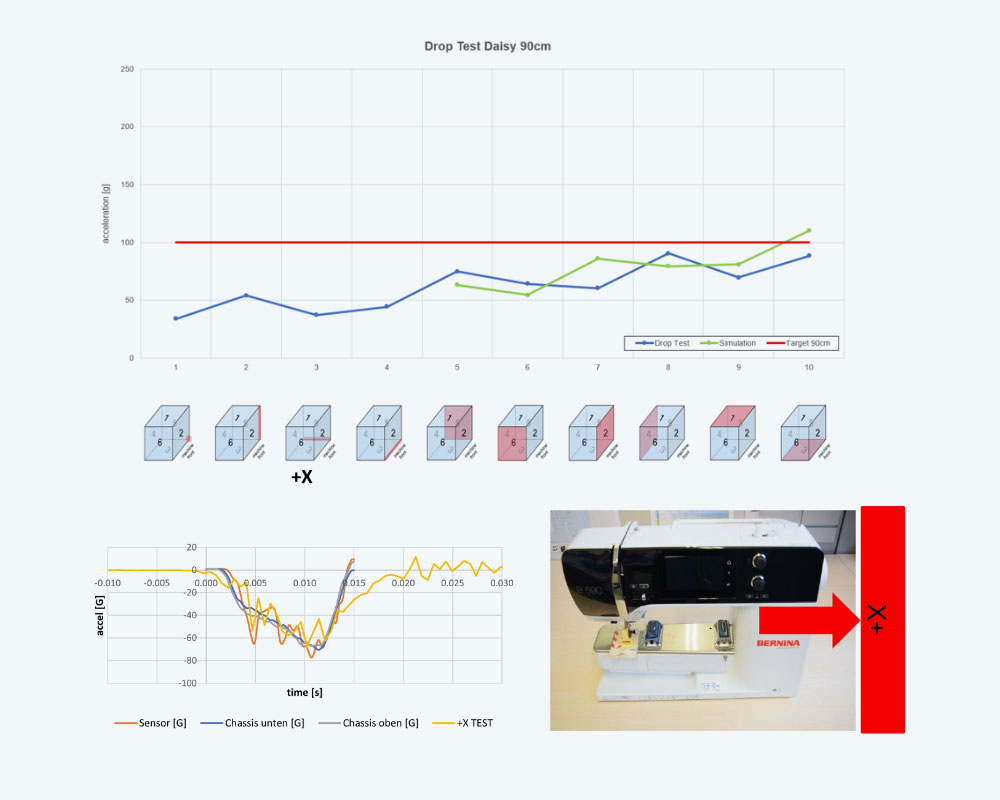More than 40% cost reduction through drop test simulation with Ansys
Sector: Consumer goods/durable goodsSpecialist field: Structural mechanicsBERNINA International AG develops and produces sewing, embroidery, overlock and quilt machines for the household and prosumer sector. A growing number of sewing machines are being sold at online stores and are being individually transported to the end customer. For a new model series, a cost-efficient and space-saving packaging had to be developed that would also provide ideal protection for the product. The drop test simulation with ANSYS enabled a new, virtual development workflow in accordance with the CADFEM motto: 10x Simulate, 1x Test.
Summary
Task
For a new sewing machine model series, packaging must be developed that fulfils the following core functionalities: <100G in all drop directions according to BERNINA drop test specification Costs <=7.5 CHF for entire packaging Styrofoam reduction >20% Dimensions adapted to US and Euro pallets.
Solution
Together with the industry partners CADFEM (simulation know-how), Flatz Austria (polystyrene development), Wellpack (carton development) and Swiss Technology Partners (material digitization), a simulation workflow was developed that is a virtual model of the time-consuming drop test. The objective was to accurately predict the G-forces acting during the drop test and to gain a detailed insight into potential problem areas and weak points in the machine or packaging.
Customer benefits
This new approach made development more efficient by requiring only two drop tests (prototype and series test). For BERNINA, the costs of the polystyrene concept were reduced by 50% and the efficiency of the pallets was increased by 30%. A new arrangement of the machine and accessories also improved the user experience when unpacking.
Project Details
Task
The cost-sensitive development project for a new sewing machine series includes optimizing the packaging to the new logistical conditions and adapting it to the new product design of the sewing machine. Packaging protection also had to be increased. In terms of specifications, this means that no acceleration forces greater than 100G may occur on the machine during a standardized drop test from a height of 0.9m. Furthermore, the use of polystyrene should be reduced by at least 20% for cost and environmental reasons. For the end customer, the package should be easy to transport by hand and leave a tidy and logical impression when unpacked, which was difficult to specify and also led to some loose ends with regard to the arrangement of accessories.
Simplified machine model:
Step 1: Simplified load-bearing structure with equivalent masses and moments of inertia
Step 2: Detailed formwork with attachment points
Ansys Granta: Ansys Granta linear and non-linear material models
Packaging model:
Step 1: Detailed packaging
Step 2: Simplified accessory elements
Step 3: Simplified machine model
Suisse Technology: Non-linear material model in LS Dyna (crushable foam) with stored measurement data
Ansys Granta: Linear and non-linear material models from Ansys Granta

Customer Benefit
Thanks to the new simulation workflow and the involvement of packaging experts during development, it was possible to achieve the goal of realizing functioning packaging with the first drop test.
By reducing the size of the packaging, the number of packages per pallet (Seafreight 1140 x 1140, CP3) could be increased from 18 to 24 machines, which corresponds to an increase of more than 30%.
The volume of polystyrene could be reduced by a factor of almost 2 compared to the previous solution. The saving of around 45% corresponds to the equivalent of CHF 2.9 per pack or savings of more than CHF 55,000 per year. Over the product life cycle (15 years), costs amounting to CHF 825,000 can be saved and CO2 emissions can be reduced by more than 225 tons (analyzed with ANSYS Granta Eco Audit).
In addition to the economic improvements, the most important point, product protection, was also improved through both packaging optimization and optimizations to the machine design. As a result, all G-values acting on the machine during the drop tests are now less than 100G. Thanks to the horizontal machine arrangement (based on the simulation results), the customer can now be impressed by both the machine and the tidy accessory arrangement as soon as it is unpacked.


Solution
To achieve the goal of a virtual drop test, various preparatory steps had to be taken before the actual simulation. In the first step, the material data was determined using material samples and the various curves from the compression tests were transferred to the LS Dyna material model.
In the second step, the machine model from CAD was reduced for the simulation to the geometries essential for the stiffness and the casing connections. The interior was simulated as realistically as possible using substitute masses and substitute beams, and the contacts between the components were defined. Linear (metal and plastic structures) and non-linear (casing parts) material data was then defined in ANSYS Granta.
The model of the packaging consists of detailed CAD data of the polystyrene, which is modeled with the experimentally determined material data. The cardboard box and the accessory data were simplified and enhanced with ANSYS Granta material models.
This modular structure of the machine model, which is separate from the packaging, made it relatively easy to model various packaging variants in a virtual drop test.
The virtual drop tests in the specified directions were carried out using the ANSYS LS-Dyna calculation tool with explicit time integration.


Cover Image: © Bernina




